Types of Electric Organs
Printed From: Progarchives.com
Category: Other music related lounges
Forum Name: Tech Talk
Forum Description: Discuss musical instruments, equipment, hi-fi, speakers, vinyl, gadgets,etc.
URL: http://www.progarchives.com/forum/forum_posts.asp?TID=20267
Printed Date: November 24 2024 at 19:28
Software Version: Web Wiz Forums 11.01 - http://www.webwizforums.com
Topic: Types of Electric Organs
Posted By: Flying Dutchman
Subject: Types of Electric Organs
Date Posted: March 14 2006 at 17:35
|
I know the Hammond B3 is the one used by Ken Hensely in Heep's classic days. But what is the "clicky" organ Emerson uses? Hammond C3 maybe? Also, what is the one that Banks uses that sounds kind of like a flute (on Can-Utility, Dancing with the Moonlit Knight)? Thanks in advance. |
Replies:
Posted By: pierreolivier
Date Posted: March 14 2006 at 20:12
|
Hi, All 3 used Hammond organs.A B3 and a C3 is essentially the same type of organ.The only difference between the two models are the different cabinet but electronically, they are the same organ. The "click" sound you heard on Emerson C3 is because he plays it with percussion engaged.Emerson also had an L-100, wich he stab with knives and jumped around. As for Tony Banks, he used spinet organs,the L-100 model in the early days and since "The lamb lies down..." he used the T-100 wich is an update model of the L-100.The spinet organs sound not as big and dirty as the B3 or C3 console models but they sound mellower and softer.Personnally, I like the spinet models more than the big consoles like the B3 and C3 and I own a L-100 since a couple of years and like it very much.With a leslie cabinet, they sound very good, like in Genesis records. Hope that it answers your questions. |
Posted By: erik neuteboom
Date Posted: March 15 2006 at 06:33
|
That 'clicky' sound is part of the tone-wheel (not an electric organ) Hammond organ and named 'key-click', it has to do with pushing a key and then making an electric contact. In fact it was a 'factory failure' but soon it turned into one ot the specific Hammond 'side-sounds' like distortion and leakage. Thijs Van Leer about the Hammond L100: "this was my main keyboard, it has a wonderful mid-dominion, very suitable for arrangements. Rick v/d Linden: "the Hammond organ is the king of the keyboards, the B3 is superior to the other Hammonds but nonetheless the L and M spinets are impressive!" |
Posted By: Sean Trane
Date Posted: March 15 2006 at 07:07
|
Another type of organ widely used was the Farsifa (used by Manzarek, Banton and a few more)
There was a cheap orange plastic organs usedby garage bands in the 60's called the Vox Continental ------------- let's just stay above the moral melee prefer the sink to the gutter keep our sand-castle virtues content to be a doer as well as a thinker, prefer lifting our pen rather than un-sheath our sword |
Posted By: Jim Garten
Date Posted: March 15 2006 at 07:48
I've an L122 myself (played through a Leslie 145) and they're wonderful instruments (considerably lighter/smaller/cheaper than the full console B3/C3s) - the only thing I'd take issue with is that unlike many players, I don't believe Tony Banks ever used a Leslie cabinet - I think his was adapted for use with a 1/4 inch jack plug to a standard amplifier. David Sinclair (Caravan) and David Stewart (Hatfield & The North, Hillage) were others who used a Hammond spinet through a standard amp, but they took advantage of this arrangement to use a great deal of guitar effects pedals, most notably wah-wah & distortion/overdrive - this in turn gives a particularly individual sound to the Hammond - almost unrecogniseable from the 'usual' sound, but still wonderful. ------------- 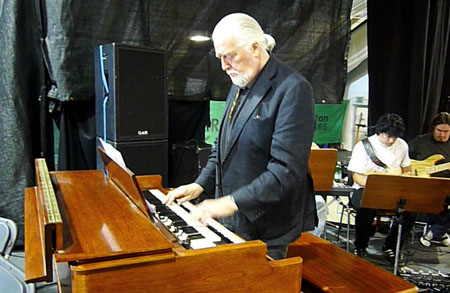
Jon Lord 1941 - 2012 |
Posted By: erik neuteboom
Date Posted: March 15 2006 at 08:02
|
I love the Farfisa Duo Organ sound by Rick Wright on Pink Floyd At Pompeii, more soaring and spacey, perfect for Pink Floyd in those days! The Vox Continental was used by The Animals (on House Of The Rising Sun), Them and Iron Butterfly. Ray Manzarek changed the Vox Continental for a Gibson combo organ, on the flat surface he could put a Rhodes Piano Bass. |
Posted By: A'swepe
Date Posted: March 15 2006 at 09:25
Eric you beat me to it. Doug Ingle of Iron Butterfly used the Vox Continental on In-A-Gadda-Da-Vida. ------------- David - Never doubt in the dark that which you believe to be true in the light. http://www.myspace.com/aardvarktxusa - Instrumental rock http://www.soundclick.com/aardvarktxusa |
Posted By: pierreolivier
Date Posted: March 15 2006 at 15:52
|
Tony Banks surely used a leslie cabinet, just listen to the organ sound of "Fountain of Salmacis" on Nursery Cryme(very leslie sounding) and many others songs.He always be very subtile in his leslie setting and never pushed it to full spin,but the leslie sound is present.My friend used to be the original keyboard player in "The Musical Box" tribute band and always had 2 leslies 147 with him during the shows.Sometimes, even the mellotron was put trought the leslie. |
Posted By: erik neuteboom
Date Posted: March 15 2006 at 16:36
| In the book Genesis The Evolution Of A Rock Band Tony Banks tells that he bought an organ (Hammond L-100) and a home-made Leslie end 1969. |
Posted By: Jim Garten
Date Posted: March 16 2006 at 03:42
Hmmm - I sit corrected (damn this truss)  ; you get so used to hearing the fast doppler effect created by the treble horns on fast setting used for emphasis, you assume a Leslie isn't present when a player doesn't use the setting... Unless Banks was using one of the smaller Leslie 110s which had the fast/slow on the bass speaker, but no treble horns (which would explain pierreoliver's 'Salmacis' reference, above) - also, the T500 Banks used later on had a built in Leslie rotating bass speaker, so he wouldn't necessarily need an additional cabinet... ; you get so used to hearing the fast doppler effect created by the treble horns on fast setting used for emphasis, you assume a Leslie isn't present when a player doesn't use the setting... Unless Banks was using one of the smaller Leslie 110s which had the fast/slow on the bass speaker, but no treble horns (which would explain pierreoliver's 'Salmacis' reference, above) - also, the T500 Banks used later on had a built in Leslie rotating bass speaker, so he wouldn't necessarily need an additional cabinet...------------- 
Jon Lord 1941 - 2012 |
Posted By: Seyo
Date Posted: March 16 2006 at 04:19
|
Jim, is it Hammond spinet that Caravan used on the album "In the Land of Grey and Pink"? Was it the same instrument used also by Steve Winwood on Traffic's "Low Sparks of High Heeled Boys" title track?
|
Posted By: oliverstoned
Date Posted: March 16 2006 at 04:38
|
Very interesting.
That would be nice to post pics to illustrate the different organ kinds/models. |
Posted By: Jim Garten
Date Posted: March 16 2006 at 07:56
OK then - my very own 1971 Hammond L122 with Leslie 145
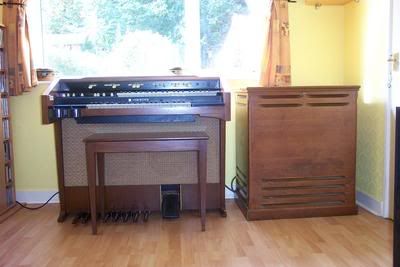
Its far bigger (and more expensive) brother, the glorious Hammond B3 
...here being (ab)used by Ken Hensley: 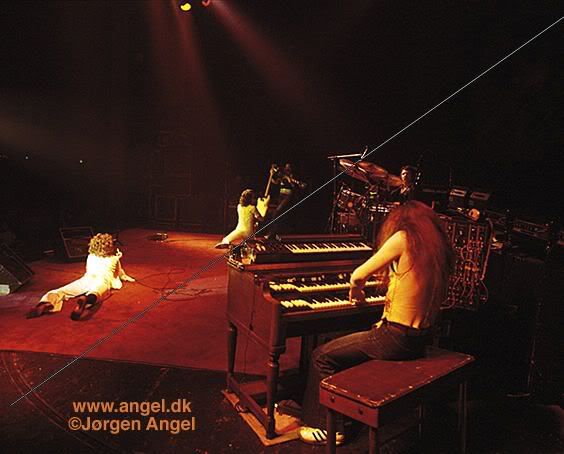
Finally (for now) - the weird, wonderful & gloriously cheesy sounding Vox Continental: 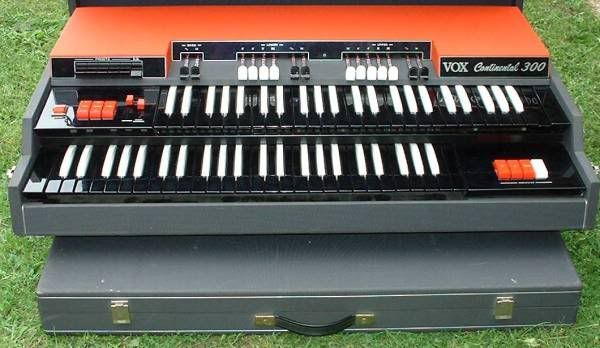
Enjoy... ------------- 
Jon Lord 1941 - 2012 |
Posted By: Jim Garten
Date Posted: March 16 2006 at 08:05
Almost certainly, Seyo - 'Nine Feet Underground' is a great example of a non-Leslied organ being played with distortion and wah-wah effect... Unless it's being played through a Dallas Arbiter fuzz pedal.... Or both...  ------------- 
Jon Lord 1941 - 2012 |
Posted By: erik neuteboom
Date Posted: March 16 2006 at 12:14
| Great pictures! |
Posted By: Rosescar
Date Posted: March 16 2006 at 13:56
|
On the first picture, that big box on the right is the amp?
------------- http://www.soundclick.com/rosescar/ - My music! "THE AUDIENCE WERE generally drugged. (In Holland, always)." - Robert Fripp |
Posted By: pierreolivier
Date Posted: March 16 2006 at 14:35
|
Hi Jim, You have a very beautiful organ and a very fine leslie.Just a little rectifier,you say that your organ was made in 1971 but according to the Hammond book "Beauty in the B" by Mark Vail,all the L models were produced between September 1961 and July 1964 so your organ may be older than you think. |
Posted By: VanderGraafKommandöh
Date Posted: March 16 2006 at 19:43
|
Hugh Banton made his own organs, by converting existing models. I shall list there details in due course (in the next few days). He was also a skilled cabinet maker as well.
-------------   
|
Posted By: Jim Garten
Date Posted: March 17 2006 at 03:07
That's a dangerous thing to say to a 'Carry On' films fan...  
Now that's interesting - I have the original Hammond warranty (but not the receipt, so I don't know how mucgh was paid) from when my little beastie was purchased from new in Exeter, Devon on 9th December 1971 (which was coincidentally my wife's 4th birthday), and given their popularity at that time, it's difficult to believe a brand new Hammond gathered dust in a shop for seven years before being bought. Are you sure Mark Vail wasn't referring to the original L100 as opposed to the L series as a whole? Incidentally, the warranty has expired... cheapskates! ------------- 
Jon Lord 1941 - 2012 |
Posted By: Jim Garten
Date Posted: March 17 2006 at 03:18
That's right - the classic combination of a Hammond Organ & a Leslie 145 cabinet; halfway down the cabinet, there's a 15" speaker facing down into a rotating drum, and at the top, the treble drivers face upwards into a pair of rotating horns; speed of rotation (fast/slow) is controlled by a switch you can just about see on the front of the organ on the left (poor picture, sorry), and the whole shebang is driven by a 45 watt valve amplifier - when you floor the swell pedal, this baby can blow the windows out! As an aside, Laurens Hammond, inventor of the original Hammond organ hated the sound of a Leslie. ------------- 
Jon Lord 1941 - 2012 |
Posted By: Jim Garten
Date Posted: March 17 2006 at 03:52
I believe Hugh Banton now has his own company making custom organs for churches... ------------- 
Jon Lord 1941 - 2012 |
Posted By: Seyo
Date Posted: March 17 2006 at 15:46
|
Thanks. A very similar sound (at least to my non-musician ears) can be heard in Traffic's "Low Spark of High Heeled Boys album title track, as well as in many Camel records. I guess that's it. |
Posted By: Seyo
Date Posted: March 17 2006 at 15:47
And thanks for beautiful pics!
|
Posted By: pierreolivier
Date Posted: March 17 2006 at 20:02
|
I think he is referring to the whole L series because he spoke about the other different cabinets like the L111 and L122 in the same article and he doesn't talk about other L models.If you talk about the Porta L,it's completely another kind of organ and had nothing to do with the original L100 serie,the Porta L is not a tonewheel organ.Don't forget that Hammond was a very special company and they doesn't take back an organ that a dealer doesn't sold.So it not impossible that your organ was in the store for a couple of years before the first owner brought it.I clearly remember when I began to became interested in Hammond organ at the age of 7,I was going to the Hammond dealer near my home and they still have older models like L100,M100 and A100 new and on sale several years after the model was discontinued. Don't forget that the ordinary Hammond consumer of the time want the latest model (even if it's doesn't have tonewheels) and as the years passed, they get stuck with a lot of unsold organs. My grand uncle had the same brought pattern as the first owner of your organ as he said to me some years ago before his passing that he brought his Hammond L102 new with Leslie 147 in the fall of 1970.Unfortunately, he sold it 12 or 13 years later to buy a newer,transistorized models with an internal Leslie(what a shame...). To concluded,in the book Mark Vail said that the T100 serie, wich was the remplacement of the L100 serie began production in March 1968.So, the production of the L100 maybe goes further than July 1964 as Mr.Vail suggest but was certainly discontinued in March 1968 when the T100 hit the market. |
Posted By: Jim Garten
Date Posted: March 19 2006 at 14:15
|
Good heavens! I may just have to look into this a bit further - I thought my L was in pretty good nick for a 35 year old - now it looks to be about the same age as me (but in considerably better condition, regrettably).
As an aside, I never much cared for the T series, as they were transistorised, rather than valve driven - there's nothing quite so soothing as the smell of a warm valve when you're playing with your organ. Also, I found their sound to be a tad harsher than the valve driven organs. ------------- 
Jon Lord 1941 - 2012 |
Posted By: pierreolivier
Date Posted: March 19 2006 at 15:24
|
The book "the Beauty in the B" is a useful book to anyone who had an interest in Hammond organs.The only dowside of it, Vail concentrate mostly on console organs like the B3,C3 and A100 but there a chapter where they recapitulate all the tonewheel models including the spinets like the L100,M100 and M3(the one I consulted to tell the date of your organ on a previous post). As for the T series,they were mainly later date organs and uses transistors but the T100 still use tonewheels.My friend(who was the original keys player in "The Musical Box")had an L100 in the beginning of the project but replace it with a T100 later on and said that it do the job pretty well. |
Posted By: Jim Garten
Date Posted: March 20 2006 at 03:45
If I had to choose a Hammond I'd love to own apart from a C3, it would be the M3 - absolutely gorgeous instrument, the king of the spinet - no silly presets, just drawbars & proper waterfall keys  ------------- 
Jon Lord 1941 - 2012 |
Posted By: pierreolivier
Date Posted: March 20 2006 at 04:15
|
I'm completely agree with you.The M3 is the king of the spinet and will like to have one in the future. |
Posted By: VanderGraafKommandöh
Date Posted: March 20 2006 at 15:47
|
There is a lot about Hugh Banton's organs, so I'll try to summarize: He first had an American Thomas, this he had from May to August 1968. Next up: Farfisa Compact Duo (same type as used on Piper At The Gates Of Dawn), that he used from August 1968 to 1969. He had the following Effects and Amps: Fluid Sound Box Distortion box WEM amp & speaks Vox Wah-Wah pedal He used this on Afterwards and Firebrand. VdGG had all their equipment stolen, so he replaced the above with a Farfisa Professional that he used 'til August 1969. The Effects and Amps for this were: 2 x Fluid Sound Box Distortion box Phasing Pedal Amps: Hiwatt + 2x 4x12 speakers Hugh Banton Custom Leslies He used this on Aerosol Grey Machine, The Least We Can Do, H to He and BBC Sessions. Nic Potter left during the recording of H to He, so Hugh decided to take over with bass duties, he acquired a Hammond E112 and modified it. This is a very complicated organ! He rewired the motor switch, so he could run the motor down independently of the organ's electronics. He used two Rotasound boxes and two amplifiers to generate a stereo "Leslie" effect. He obviously incorporated bass pedals into this too and they had their own amplifier and reflex speaker (built by Nic Potter). Additionally, Hugh built a remote stereo Hammond spring reverberation unit, which was amplified through two speakers, which he located wide of the stage. This was used on Pawn Hearts and BBC sessions, here are details: Effects & Amps: 2 x Schaller Rotosound WEM Copycat echo Echo & organ motor switches 3 x Distortion; 1 x Overdrive Hugh Banton Stereo spring reverb Amps: 6 x 100W channels 4 x 4x12; Hugh Banton Bass speaker 2 x WEM speakers for reverb He used this organ from 1970 through to 1973 and used the Farfisa Professional alongside it, particularly on White Hammer. The band split-up and then reformed... in this time, Hugh started to build his HB1, which was his very first custom organ. But he hadn't completed this in time for the re-formation of the band, so he rented a Hammond C3 with pedals, Leslie and re-used the tape echo and motor switch from the previous set-up. The details are: Effects & Amps: WEM Copycat echo Leslie RTR speakers and amps. He used this on Godbluff, Still Life and World Record. He then finally completed HB1. This contained the original Hammond keyboards and generators from the E112, coupled with three new build electronic generators sets intended to provide all the Farfisa sounds and more. The American RTR cabinets utilised 24" bass speakers, which reproduced 32-foot (16Hz) organ tone. Details: Effects and Amps: WEM Copycat echo 4 x 100W amp channels 2 x RTR speakers He used this on BBC sessions. Now, we fast forward to 2005. He now uses: Roland VR-760 Roland VK-7 MIDI pedal-board and the following Effects & Amps: Line6 Delay Modeller Hugh Banton 6x 125W amplifiers 4 main, 1 sub speaker Hugh Banton custom Leslie He's modified an original '70s organ-pedal board to provide velocity-sensitive MIDI for the bass and the Line6 is used for authentic tape-echo effects. And Jim, he has had a career as a church organ builder. I hope this is of some use! He used this on Present and all the live gigs from 2005. -------------   
|
Posted By: Jim Garten
Date Posted: March 21 2006 at 03:33
 
Cheers Geck0, interesting roundup of Banton's gear: "He then finally completed HB1. This contained the original Hammond keyboards and generators from the E112, coupled with three new build electronic generators sets intended to provide all the Farfisa sounds and more. The American RTR cabinets utilised 24" bass speakers, which reproduced 32-foot (16Hz) organ tone." That must have been some beast - the E112 was not what you could call a compact organ in the first place... ------------- 
Jon Lord 1941 - 2012 |
Posted By: Jim Garten
Date Posted: March 21 2006 at 03:41
By the way, Pierreolivier - I've just ordered a copy of "Beauty In The B"; sounds like the perfect book for an old saddo Hammond anorak like myself...   ------------- 
Jon Lord 1941 - 2012 |
Posted By: pierreolivier
Date Posted: March 21 2006 at 10:13
|
Yes sir!,that's a beautiful book.You won't be dissapointed. |
Posted By: VanderGraafKommandöh
Date Posted: March 21 2006 at 13:04
Here are some screen shots of Hugh Banton playing with VdGG in Belgium in 1975: 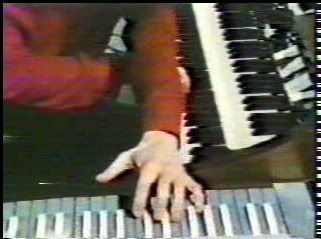  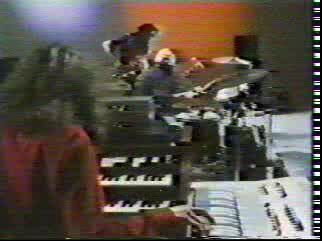 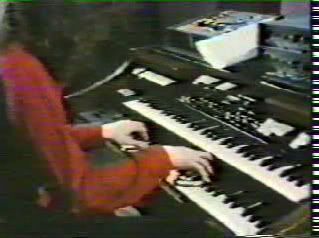 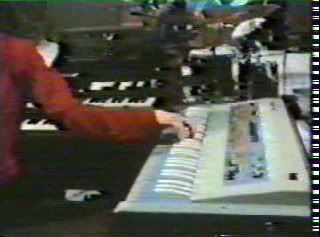 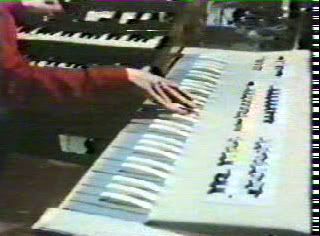 -------------   
|
Posted By: erik neuteboom
Date Posted: March 21 2006 at 14:35
|
A few years ago I wrote a review in a Dutch progrock magazine about the aforementioned Hammond book by Mark Vail, it's recommended to every Hammond aficionado!
MARK VAIL – THE HAMMOND ORGAN (Beauty in the B) (Miller Freeman, 1997, US $ 24,95, ISBN 0-87930-459-6) There has always been a strong relationship between progressive rock and the Hammond organ: this powerful and varied instrument fits perfectly to the alternating and dynamic music that good progressive rock features, from Colosseum, The Nice and ELP to Spock’s Beard, Ars Nova or very recently Niacin. This book (240 pages) is presented by the known magazine Keyboard with a foreword by their editorial director Dominic Milano. It’s layered with photos from all kinds of Hammond organs (from the legendary B3 to Model A and C, Grand 100, the ‘spinets’ L and M and the colossal X-77) and some exciting pictures from Keith Emerson and other ‘Hammond aficionados’ like Tom Coster and Rod Argent. Chapter 7 contains tips from famous players like Jimmy McGriff, Keith Emerson and Paul Shaffer, popular B-3 drawbar configurations like the ‘ELP - and Argent sound’ and the “Green onions” groove and known Hammond licks. Some chapters are a bit technical for the average ‘proghead’ (buying and maintaining, vital statistics and details about all the known Hammond organs) but most chapters are at least interesting like the story about the inventor Laurens Hammond. He started with clocks, an automatic bridge table and a 3-D viewer and then invented the tone wheel mechanism of the Hammond organ! Of course this book contain a chapter about the Leslie speaker, the ideal combination with a Hammond organ. Also included is a comprehensive list of adresses (also E-mail and Internet), a Hammondology (instruction video’s and sampling CD’s) and a glossary (from the words “envelope” and “spinet” to “vibrato”). Reading this book was fun and excitement for me because it’s written fluent with lots of fine details and it’s not too technical, typcial Hammond sounds like ‘drawbars’ and the ‘key-click’ are explained very clearly. So I would like to recommend The Hammond Organ to all ‘progheads’ who wants to know more about the instrument that sounds so well and distinctive on ‘classic recordings’ like “A whiter shade of pale” from Procol Harum, “Child in time” from Deep Purple, “Pictures at an exhibition” from ELP, “Tomorrow night” from Atomic Rooster or “Close to the edge” from Yes. |
Posted By: Jim Garten
Date Posted: March 22 2006 at 03:58
Oooohhh - that E112 is a beast! ++drool++ ------------- 
Jon Lord 1941 - 2012 |
Posted By: Sean Trane
Date Posted: March 22 2006 at 04:04
|
yes, but those pictures are not from the 75 Godbluff concert , but from the 71 TV special on the same DVD, I think ------------- let's just stay above the moral melee prefer the sink to the gutter keep our sand-castle virtues content to be a doer as well as a thinker, prefer lifting our pen rather than un-sheath our sword |
Posted By: VanderGraafKommandöh
Date Posted: March 22 2006 at 09:28
|
Yes, it's from the Lighthouse Keepers performance, my mistake! I was thinking of the later date for some reason. Sorry for the confusion. This is obviously the case too, as the E112 was not in use in 1975. -------------   
|
Posted By: Peter
Date Posted: March 22 2006 at 17:26
|
Aw... have a heart!
There ya go, Jimminy! Dig the beat! ------------- "And, has thou slain the Jabberwock? Come to my arms, my beamish boy! O frabjous day! Callooh! Callay!' He chortled in his joy. |
Posted By: Jim Garten
Date Posted: March 23 2006 at 03:23
|
If it's all the same to you, professor, I'll stick to my trusty steam driven bakelite 1960's vintage heart - these new plexiglass & chrome jobs are all very well for fancy "look how many beats per minute I can get" prog-metal fans, but for us purists (especially those of us who still smoke), the organic feel of a trusty (crusty?) old valve (with properly diseased arteries) warms the cockles of your heart...
+++cough+++ ------------- 
Jon Lord 1941 - 2012 |
Posted By: Jim Garten
Date Posted: March 23 2006 at 03:26

I'm not! What a book - I can now bore all my friends even more with Hammond lore; an example: did you know that before inventing the Hammond Organ (or "electric flute", as he called it originally...), Laurens Hammond invented the self shuffling/dealing bridge table  ------------- 
Jon Lord 1941 - 2012 |
Posted By: pierreolivier
Date Posted: March 23 2006 at 13:46
Yes, I've seen the photo in the book.It's quite a weird looking table.I shown the photo to my father,who is an amateur bridge player and he was quite fascinated by the table altrought he say that it's a kind of gadget.Apparently, the table sold very well and the price was something like $25, in the depression era it was a lot of money for something luxurious. |
Posted By: Jim Garten
Date Posted: April 18 2006 at 07:43
|
Incidentally (and as I'm too lazy a bugger to look it up myself) does anyone know the organ used by Dave Greenfield on The Stranglers' early albums? ------------- 
Jon Lord 1941 - 2012 |
Posted By: B3Nut
Date Posted: April 18 2006 at 13:29
Actually, Vail's book isn't 100% accurate. The L-100 series continued to be built well into the early 70's. I had a '67 L-112 at one point, some of its parts are in my '63 L-100. Vail's book has a lot of nice pictures, but there are errors. The Hammond Age List has this error in the L-100 list heading, but there are plenty of post-'64 organs represented and the serial number data are accurate. The age list can be found at http://www.prevailingwinds.net/agelist/agelist.php and there is a link to the Hammond-Leslie FAQ at www.hamtech.org (mailing list for organists and techs, I've been a member since '95, an eternity in net-time! :D ) That's a really nice L-122 there, that's my favorite L-100 series cabinet style. I love my little L-100, doesn't do some of the things my B-3 does but it has its own unique vibe, and taken on its own terms is an expressive little instrument. I love being able to route the reverb through the Leslie, you can get spacey sounds doing that! :) Todd in Beerbratistan |
Posted By: Jim Garten
Date Posted: April 20 2006 at 03:16
Thanks B3Nut, I couldn't see this little beauty sitting around for 7 years before being sold, especially given their popularity in the late '60s.
Also, at some point in its life a variable bass pedal sustain unit has been professionally fitted. The control knob for this can just about be seen to the right of the control tabs; strange modification really, given that my Hammond has only ever had home use. ------------- 
Jon Lord 1941 - 2012 |
Posted By: B3Nut
Date Posted: April 20 2006 at 16:08
|
I see you're in England, the L's were very popular over there. If it has pedal sustain, that would make it an L-122S. Pedal sustain was an option installed by the European importers (in this case, Boosey & Hawkes). The Belgian Hammond distributor did this as well, offering options not available on US-sold instruments. They even made an A-100 with pedal sustain. Microtechnica in Italy assembled Hammonds, and Boosey&Hawkes had an operation in South Africa assembling them as well. Your L-122 would have to be post-69, it has the large HAMMOND logo with the stylized "H" (that didn't appear until around 1970). So, 1971 is about right. In 1966 they went from the small font to a large font, then around '70 went to that even larger blockier font with the big H logo. My L-112 had the post-'66 large font, as does my '67 M-102 (which I found alongside the road on its back with someone's garbage...I wasted no time rescuing the poor mutt! Still needs a little work yet...) European Hammonds were, with the exception of the B-3 (which had a complicated-to-manufacture cabinet), assembled in Europe with the cabinetwork made locally. The guts were shipped as "tray organs" from the plant in Chicago. This saved a lot of shipping costs. Leslie did the same thing, European Leslies had locally-made cabinets with only the amps/motors/drivers/hardware coming from Pasadena. Todd in Beerbratistan (pet name for the state of Wisconsin, the enchanted land of brats, beer, and cheese :D ) |
Posted By: B3Nut
Date Posted: April 20 2006 at 16:10
I once saw a photo of him playing an L-122, but I've never heard the records so I'm not sure. Todd in Beerbratistan |
Posted By: pierreolivier
Date Posted: April 20 2006 at 17:49
|
Thanks for the clarification, B3Nut. Me too was a little suspicious about the 1964 date but was thinking if Mark Vail,who is supposed to be a vintage keyboards specialist write that date in his book,this date must be accurate.I was wrong.I'm not a specialist on Hammond organ and takes my informations on the "Beauty in the B" book and from a former Hammond dealer where I went very often as a kid. Personnally, I had an Hammond L-112 with the stylized "H" and large Hammond logo,so it must be post-69.Thanks for the infos,that's very interesting. |
Posted By: Jim Garten
Date Posted: April 21 2006 at 03:14
|
This is splendid - not only has B3Nut completely clarified the age of my little beastie (giving me plenty of trivia to bore my friends with even more than usual), but there's also a possibility that Dave Greenfield used the same model as I own... others I've seen using my setup include Tjis Van Leer from Focus (Old Grey Whistle Test 1972)and Keith Emerson (a very battered version in a film I saw of him playing in The Nice).
All I need to do now is to learn to play better than I actually can... which is very little at present!  ------------- 
Jon Lord 1941 - 2012 |
Posted By: B3Nut
Date Posted: April 21 2006 at 09:19
|
Ah yes, Thijs Van Leer...extremely musical player. He's not showoffish at all, kind of an anti-Emerson. :) Peter Bardens (rest his soul) from Camel was another player like that, amazing taste. Van Leer got a lot of music out of the L-100, Live At The Rainbow (hey, L-122 again!) is brilliant. Vail did an OK job with what he had to work with, but some revisions would be in order. It's still a nice coffee-table book to have around, it can be helpful in explaining one's Hammond obsessions to puzzled visitors. :) They will get to you though, you'll start prowling estate sales and such for them. They turn up in wierd spots too, especially in the US given Americans' propensity to throw things away they don't understand. Witness the M-102 I found in someone's trash in Madison, or the Hamtech list member who recently found an A-100 and 122 in someone's trash! Talk about a good save...I shudder to think of these machines going into a garbage truck and being smashed! Todd in Beerbratistan |
 pierreolivier wrote:
pierreolivier wrote:

